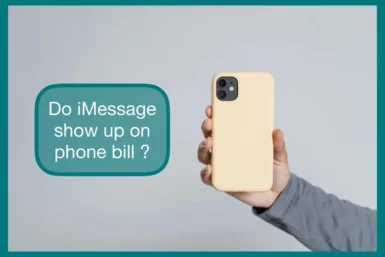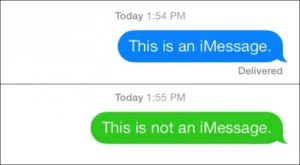This article will clarify the complexities of iMessages and your phone bill and reveal whether iMessages show up on your phone bill.
So, whether you’ve been worried about privacy or are just interested in how Apple’s communication system works, we will answer all your questions in this article.
Distinguishing iMessages From Regular Messages
iMessages and standard text messages may appear to be the same at first sight, but there are a few important distinctions.
Regular text messages, often known as SMS (Short Message Service), transfer data through your mobile network. On your iPhone, these texts are displayed in green bubbles.
iMessages, on the other hand, are exclusive to Apple devices and use data or Wi-Fi instead of your cellular network to deliver messages. You can readily tell an iMessage from a standard text message by the blue bubbles that iMessages have.
iMessages: Enhanced Messaging Experience
iMessages provide a messaging experience that is far richer and more interactive than text messages. You may send and receive text, pictures, videos and even exhibit different emotions in response to communications.
Additionally, you can benefit from functions like group messaging, read receipts, and typing indicators that are not offered by conventional text messaging.
Regular Messages: Accessibility and Universality
Regular text messages don’t offer as many capabilities as iMessages. Still, they do have one benefit over them: they can be sent and received by almost any mobile phone, regardless of its brand, model, or operating system.
SMS texts can connect you with anyone who owns a mobile phone, making them widely accessible, unlike iMessages, which are only available to Apple customers.
Do iMessages Show Up on Phone Bill?
Phone bill appears different for each carrier . Some of the famous carriers include:
1. AT&T and iMessage: What Appears on Your Bill?
Your statement will provide usage information, such as phone calls and regular SMS text details if AT&T is your service provider. It won’t, however, provide any information about iMessages.
iMessages don’t count as standard SMS texts because they consume your internet data when Wi-Fi is accessible or cellular data when Wi-Fi is not, respectively. As a result, they won’t show up as separate line items on your phone bill.
2. T-Mobile and iMessage: Billing Details
Like AT&T, T-Mobile bills likewise do not display specific iMessages. Rather, iMessages count towards your data use like any other internet-connected program. The bill just shows the total amount of data you utilized, not the specifics of what was done with it.
3. Verizon and iMessage: Understanding Your Bill
Verizon is regulated by the same rule. Data consumption information will be included on your phone bill, but it won’t be broken down by specific applications or services, such as iMessage.
Therefore, even though your iMessage activity uses data, you won’t find these iMessages specifically stated on your Verizon statement.
What Type of Messages Are Shown on Phone Bills?
These are the two types of messages that are shown on the phone bill:
Standard SMS Text Messages: Listed on Your Phone Bill
Traditional SMS text messages will normally appear on your phone bill when sent. Service providers like AT&T, T-Mobile, Verizon, and others will list the specifics of each text message sent and received, including the associated phone numbers and timestamps.
Depending on your plan, the number of texts may also be divided into groups like local, national, or worldwide texts.
Multimedia Messages (MMS): Displayed on Your Bill
Multimedia messages (MMS) are included in the same category as conventional text messages on your phone bill. MMS messages can incorporate material such as photos, videos, audio files, and other media types.
These MMS messages will be itemized separately by your service provider, and they might incur additional fees for the data used to send the multimedia information.
How Can You See iMessage History?
The steps below can be used to view your iMessage history:
1. On your iPhone or iPad
- Your device’s “Messages” app should be open.
- To discover a certain person or message, scroll through your conversations or use the search bar at the top.
- To view a chat, tap on it to open it.
- Your iMessage history, which includes both sent and received messages, will be seen.
2. On your Mac
- On your Mac, open the “Messages” app.
- Select the contact or conversation you want to view by clicking it in the left-hand sidebar.
- Your iMessages will be displayed in the main window’s conversation history.
Note
You should be aware that your iMessage history can only be accessible on the device from where the messages were sent or received.
End-to-end encryption and iCloud synchronization protect your iMessages, but they might not be available on devices if you haven’t checked in with your Apple ID.
Your iMessage history will also be stored in iCloud if “Messages in iCloud” is enabled in your device settings. If so, you can view it from other Apple devices logged in with the same Apple ID. This guarantees that your iMessage history will still be synchronized and available even if you switch devices.
Conclusion
In conclusion, regardless of your service provider, iMessages don’t show up on your phone bill. Unlike regular SMS texts, iMessages use data or Wi-Fi and are not separately itemized on your bill. Remember that the Messages app on your Apple device allows you to view your iMessage history.



